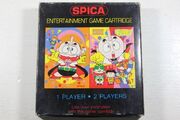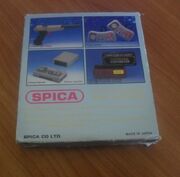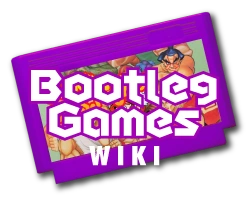Spica Co., Ltd., also known Keyman Electronics Co., Ltd.[1] was a Taiwanese distributor of pirated NES games. They sold games for the NTSC and Asian NES and Famicom consoles.
Company Background[]
Not much is known about Spica, but they seem to have been a rather large company. Their games were sold in North America and Australia, in addition to several countries that received the Asian Version NES instead of the Famicom.
Releases[]

Generic Spica box used for single-game carts.

Back of a different box showing Spica's other products.
Spica released a mixture of multicarts and single games, as well as Famicom-NES converters and other accessories. The carts were supposedly made in Japan, though they were likely made in Hong Kong or Taiwan. Most of their games used the same box and label art, with a plain sticker on the top with the game's title. Spica's cartridges were specially made with a molded Spica logo. Spica did not alter the games in any way prior to releasing them, even the copyright notices were left unchanged. It is unknown if their multicarts contained hacked games, as the carts had been released by other companies and wouldn't have been changed.
Spica also released the 52-in-1 multicart that Action 52 was based on, though it is unknown if they were the original creators.
They also distributed some Sachen games in Australia in Famicom format.
Hardware[]
Several NES clone systems and accessories were released under the Spica brand, which seem to be mostly rebranded Micro Genius products. Their consoles included:

An Australian advertisement for the IQ-701
- IQ-701 - identical to the equivalent Micro Genius console aside from the Spica branding
- SP-801 - closely resembles the original NES. No Micro Genius equivalent is known, but the console was shipped with standard Micro Genius-style controllers.
Demise[]
What ever happened to Spica is unknown. However, following a lawsuit against a company distributing its IQ-701 Famiclone console in Australia, it left the Australian market.
'New old stock' of Spica's games can occasionally be found online.
Box/Label art[]
Most of Spica's box/label arts are originated from Japanese mangas and animes, usually completely unrelated to the actual content of the cartridge. These arts are directly ripped from the original source without any altering, so they sometimes contain Japanese statement that doesn't make sense to be printed on a video game label such as "coloring book" and "sing-a-song included".
The box art shown above comes from Choujin Kintaman (超人キンタマン), a Japanese manga started in 1981 and ended in 1987. This is rather unusual choice for a game box art, since the manga never had a video game about it. Another box art uses an artwork from GeGeGe no Kitaro (ゲゲゲの鬼太郎), a Japanese manga which actually had a couple of Famicom games about it. However, the art is not taken from the games.
